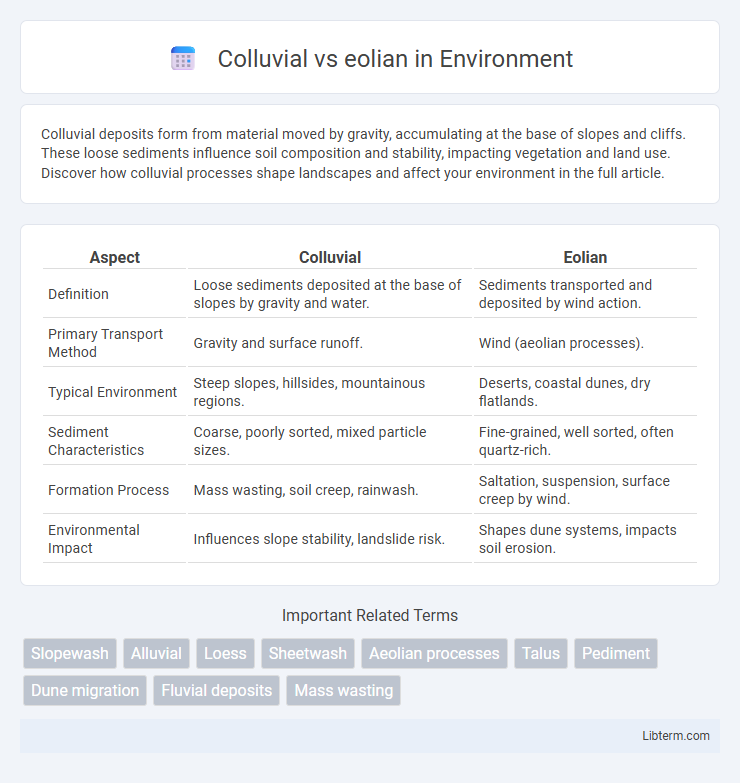Colluvial deposits form from material moved by gravity, accumulating at the base of slopes and cliffs. These loose sediments influence soil composition and stability, impacting vegetation and land use. Discover how colluvial processes shape landscapes and affect your environment in the full article.
Table of Comparison
| Aspect | Colluvial | Eolian |
|---|---|---|
| Definition | Loose sediments deposited at the base of slopes by gravity and water. | Sediments transported and deposited by wind action. |
| Primary Transport Method | Gravity and surface runoff. | Wind (aeolian processes). |
| Typical Environment | Steep slopes, hillsides, mountainous regions. | Deserts, coastal dunes, dry flatlands. |
| Sediment Characteristics | Coarse, poorly sorted, mixed particle sizes. | Fine-grained, well sorted, often quartz-rich. |
| Formation Process | Mass wasting, soil creep, rainwash. | Saltation, suspension, surface creep by wind. |
| Environmental Impact | Influences slope stability, landslide risk. | Shapes dune systems, impacts soil erosion. |
Introduction to Colluvial and Eolian Processes
Colluvial processes involve the downslope movement of soil and rock primarily due to gravity, resulting in deposits typically found at the base of slopes or hillsides. Eolian processes are driven by wind activity, which transports and deposits fine particles like sand and dust in diverse environments such as deserts and coastal dunes. These distinct geomorphic mechanisms shape landscapes through sediment redistribution, influencing soil composition, terrain stability, and ecosystem development.
Defining Colluvial Deposits
Colluvial deposits consist of loose, unconsolidated sediments that accumulate at the base of slopes due to gravity-driven processes such as rockfalls, landslides, and soil creep. These deposits typically include a mix of rock fragments, soil, and organic material, often displaying poor sorting and angular clasts. Unlike eolian deposits formed by wind action, colluvial sediments are primarily shaped by mass wasting and surface runoff, leading to characteristic accumulation patterns in proximal, slope-adjacent environments.
Understanding Eolian Deposits
Eolian deposits consist primarily of wind-transported sediments such as sand, silt, and dust, characterized by well-sorted grains and distinctive cross-bedding patterns. Unlike colluvial deposits formed by gravity-driven processes on slopes, eolian sediments accumulate in dunes, loess plains, and desert pavements through aeolian processes. Their mineral composition and sorting provide essential clues to past climatic conditions and wind regimes in sedimentological studies.
Key Differences Between Colluvial and Eolian Sediments
Colluvial sediments are primarily deposited by gravity-driven processes such as landslides and soil creep, leading to poorly sorted, angular particles typically found at the base of slopes. Eolian sediments are transported and deposited by wind, resulting in well-sorted, fine-grained materials like sand dunes and loess deposits often found in arid and semi-arid environments. The key differences lie in their transport mechanisms--gravity versus wind--and resulting sediment characteristics, including sorting, grain shape, and depositional environment.
Formation Mechanisms: Gravity vs. Wind
Colluvial deposits form primarily through the action of gravity, where soil and rock fragments move downslope due to processes like landslides, soil creep, and debris flows. Eolian deposits, in contrast, result from wind-driven transportation and accumulation of fine particles such as sand and silt, often forming dunes or loess plains. The dominant mechanism in colluvial formation is gravitational pull on loose materials, whereas eolian formation relies on aeolian processes involving wind erosion, transport, and deposition.
Typical Locations of Colluvial and Eolian Deposits
Colluvial deposits typically accumulate at the base of slopes, in mountainous and hilly terrains where gravity-driven processes like landslides and soil creep dominate. Eolian deposits are commonly found in arid and semi-arid regions, forming extensive dune fields, desert plains, and loess-covered plateaus shaped by wind transport and sedimentation. The geographic distribution of colluvium is closely linked to steep topography, whereas eolian sediments prevail in open, dry landscapes with sparse vegetation.
Physical Characteristics and Grain Size Comparison
Colluvial deposits typically consist of poorly sorted, angular to sub-angular grains ranging from clay to boulders, reflecting gravity-driven sediment transport processes such as landslides and debris flows. In contrast, eolian deposits are well-sorted, fine to medium sand-sized particles with rounded grains, shaped by wind-driven transport and deposition. The physical characteristics of colluvial sediments often include heterogeneous layering and coarse fragments, whereas eolian sediments exhibit uniform stratification and fine textures.
Environmental and Ecological Impacts
Colluvial deposits, formed by gravity-driven processes such as landslides and soil creep, significantly influence slope stability and sediment transport, often creating habitats with high nutrient availability that support diverse plant communities. Eolian deposits, shaped by wind action, contribute to the formation of sand dunes and loess plains, impacting soil texture and moisture retention, which affects vegetation patterns and microclimates in arid and semi-arid ecosystems. Both colluvial and eolian processes play crucial roles in landscape evolution, soil fertility, and ecosystem dynamics, with varying effects on erosion rates, habitat heterogeneity, and carbon sequestration potential.
Importance in Geological Studies
Colluvial deposits, formed by gravity-driven processes like landslides and soil creep, provide critical insights into slope stability and tectonic activity, essential for hazard assessment and landscape evolution studies. Eolian sediments, transported and deposited by wind, reveal past climatic conditions and surface environments, offering valuable data for paleoenvironmental reconstruction and sedimentary geology. Understanding the distinctions between colluvial and eolian deposits enhances the interpretation of sedimentary processes and stratigraphic records in geological research.
Summary: Choosing the Right Term in Context
Colluvial refers to sediments deposited by gravity-driven processes like landslides or soil creep, typically found at the base of slopes, while eolian pertains to wind-driven sediment transport and deposition, common in deserts and dune environments. Selecting the correct term depends on identifying the dominant natural agent responsible for sediment movement in a given context. Accurate usage enhances geological clarity by specifying whether gravity or wind shapes the landform or sediment characteristics.
Colluvial Infographic

 libterm.com
libterm.com